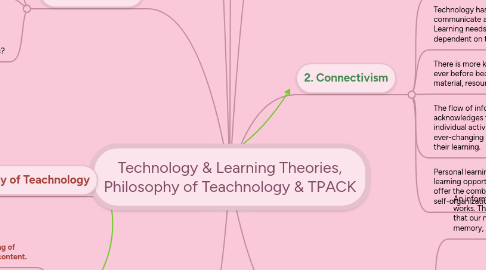Technology & Learning Theories, Philosophy of Teachnology & TPACK
by Michelle LePage


1. 2. Media Ecology
1.1. The study of media environments, specifically how they affect people socially.
1.2. Investigates how media communication affects our perception, feelings, understanding and personal value systems.
1.3. Examples of media environments include: film, television, books and radio. How do these medias affect students in the classroom? What forms of media are they exposed to at home that can affect how they feel, how they act, etc?
2. 1. Social Construction of Technology (SCOT)
2.1. Theory that human action shapes technology. Understanding the links between technology and social constructions.
2.2. Idea that the success of any technology can only be evaluated properly if that technology has been understood to work a certain way in the social world.
2.3. Way to examine the social context of technological advances. Technology is based on human need and can only be successful if it is desired by the socially.
2.4. In a teaching context, if there is evidence that a technological tool does not support learning, then that technology will not be desired or used by teachers or students. Conversely, if there is evidence that a new advance in technology supports learner outcome, then the implications for that technology in education are huge.
3. Technology Theories
4. Philosophy of Teachnology
4.1. Teacher's philosophy about how to use technology as teaching tools
4.2. Philosophy is developed based on teacher's beliefs, values & students' capability to learn.
4.3. Technology tools for teaching enhance literacy & writing opportunities.
4.4. Hands-on approach to communication, investigation and exploration.
5. TPACK (Technology Pedagogical Content Knowledge)
5.1. Effective teaching requires understanding of how technology relates to pedagogy & content.
5.2. There are 3 primary forms of knowledge in the TPACK framework that teachers should have to be able to decide what kinds of technology will be best suited for students' learning & success.
5.2.1. 1. CONTENT (CK)
5.2.2. 2. PEDAGOGY (PK)
5.2.3. 2. PEDAGOGY (PK)
5.3. Identifies the nature of knowledge needed by teachers for technology integrationIdentifies the nature of knowledge needed by teachers for technology integration
6. 1. Constructivist
6.1. Students learn better when they are actively involved in their learning experience, rather than passively listening. Problem solving, group activities, peer collaborations and hands-on experiments are teaching strategies that support constructivm.
6.2. Reconciling new knowledge learned with what is already known. This new knowledge might change beliefs or have us throw away new information if we find it irrelevant. Engaging students and allowing them to be creative gives them ownership of what they learn.
6.3. Construct own understanding & knowledge through real experiences & reflect upon them. We create our own knowledge through exploration and questioning.
6.4. Learning how to think and understand rather than memorize allows for long-term knowledge.
6.5. Today's classroom is a good example of constructivism. We are seeing more desks grouped together, more students working in groups out in the hallway and more general interaction and idea sharing than ever before.
7. Learning Theories
8. 2. Connectivism
8.1. Students are learning in a digital age where many forms of technology are used as teaching tools. Some examples are computers, ipods, ipads, smart tables, and smart boards.
8.2. Technology has changed how people communicate and how we live and learn. Learning needs have interchangeably become dependent on technology.
8.3. There is more knowledge out there to learn than ever before because we have more access to material, resources through being connected.
8.4. The flow of information within diverse social networks acknowledges that students’ learning is no longer an internal or individual activity. If we stay current with the fast and ever-changing technological advances, our students will benefit in their learning.
8.5. Personal learning networks create unlimited learning opportunities through exploration and offer the combination of network and self-organization.
9. 3. Cognitive Load
9.1. An information processing theory that explains how the mind works. There are limits to the working memory based on the fact that our minds are structured to have working memory, long-term memory, and schemas.
9.2. There are three types of Cognitive Load. Due to the mind's limited working memory space, overcompensating one means taking away from another.
9.2.1. 1. EXTRANEOUS LOAD: Caused by inappropriate instructional designs that reduce the working memory's capability to build schemas into long term memory
9.2.2. 2. INTRINSIC LOAD: Caused by the complexity of elements interacting with working memory, which cannot be reduced.
9.2.3. 3. GERMANE LOAD: Caused by effortful learning in building Schema and automation.
